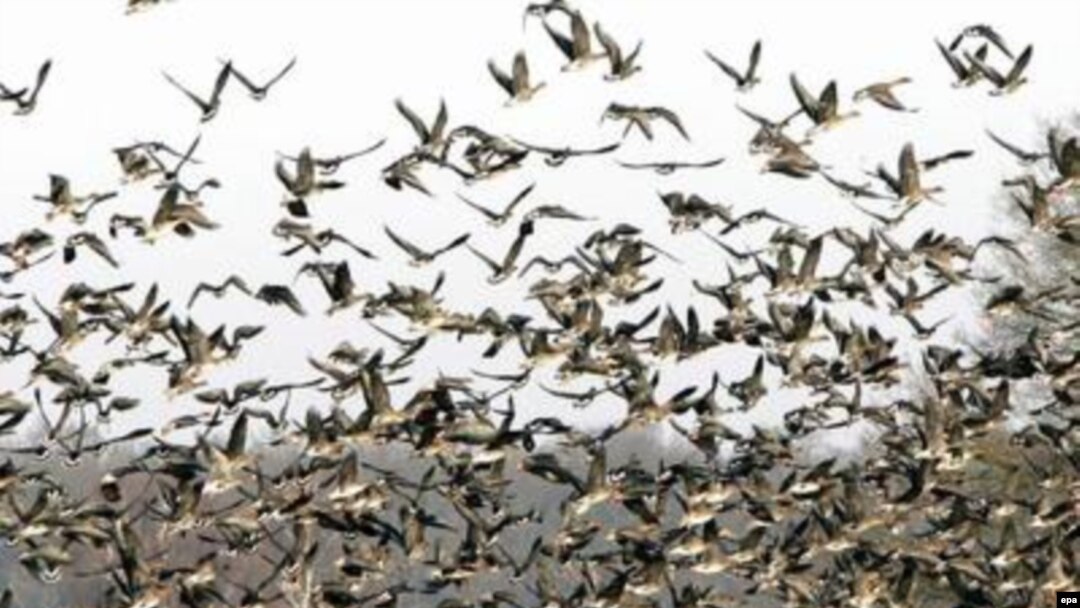By Kathleen Moore and Ahto Lobjakas
http://gdb.rferl.org/E249EDBB-E4D4-496A-B7A3-9A44A68F04B3_w203.jpg
Wild birds in Germany last month (epa)
Every day, it seems, brings a new bird-flu story that alarms Europeans. Germany today became the latest EU country to confirm the presence of the deadly H5N1 strain in wild swans, following similar announcements by Italy and Greece. The cases have prompted renewed fears about the spread of the disease. But experts say they also show the benefit of surveillance and control measures.
PRAGUE, 16 February 2006 (RFE/RL) -- Germany's announcement confirmed what preliminary tests had already shown -- that two dead swans found on an island in the Baltic Sea had the strain of bird flu potentially dangerous to humans.
The announcement came fast on the heels of similar news from Italy, Greece, and Austria.
"I think it is a worrisome situation, especially because we think that swans could be an indicator species, meaning that swans are relatively susceptible and so it could well be that other aquatic birds could be infected," says Albert Osterhaus, a virologist at the Erasmus Medical Center in the Netherlands. "Now we have seen it in Greece and Italy and now Germany. It is spreading all over Europe."
The outbreaks have prompted fears among many European consumers. Poultry sales have dropped dramatically in some EU countries, though experts say it's safe to eat poultry that is properly cooked and handled during preparation.
Silver Lining Amid The Panic
But amid the worry, some see positive signs. Among them, that the detection of the outbreaks themselves show the effectiveness of proper monitoring and control measures.
"We don't have a spread of the virus, what we have is the introduction of the virus into countries of the European Union," says Juan Lubroth of the UN's Food and Agriculture Organization (FAO). "The difference is that it's human activities, through commerce, through the market place, through the way we raise our poultry that we get disease spread. The fact that in Europe, in many countries, it's been picked up in migratory birds, is very, very relevant, it means that the European authorities -- Italy, Greece, Germany, Denmark, Austria -- are monitoring, doing active surveillance in the wild bird population."
This is aimed at stopping the virus from spreading from wild birds to poultry farms, where there is a greater chance it could infect humans.
The FAO on 13 February praised Italy in particular for how it handled the discovery of the virus in six dead swans in the south of the country. It said authorities quickly cordoned off the area, stopped the movement of any poultry nearby, sent samples for testing -- and went public with the information.
Approaching Critical Mass?
But while this may give some reason for cheer, experts also say there's no room for complacency. The human death toll from H5N1 bird flu now stands at around 90, the victims mainly people in Southeast Asia who likely caught it through contact with infected birds.
The virus can't pass easily from person to person. But the worry is that if the virus is given enough opportunities, it could change into a form that can do just that.
German Agriculture Minister Horst Seehofer said today he expected new cases in his country. And Ian Jones, a virologist at Reading University in the United Kingdom, says we need to stay vigilant.
"One of the problems with the outbreak at the moment is that it suffers from periodic news coverage," Jones says. "It can either be very intensive coverage or, like currently in the U.K., there's very little coverage at all. And yet the situation has not changed, it remains a major threat to human health. It's very important that we continue to monitor migratory birds and outbreaks as they occur in domestic fowl."
EU experts are currently meeting in Brussels to discuss a common strategy. European Commission spokesman Philip Tod said today they are expected to adopt a decision creating uniform EU-wide rules on how to respond to detected cases of the H5N1 virus in wild birds.
"The member state has to establish a 3-kilometer protection zone around the holding where the, around the area where the [infected] wild bird had been found, and a further surveillance zone of an additional 7 kilometers around the protection zone," Tod says. "Within both zones, all poultry and captive birds must be kept indoors, disinfection measures have to be applied in holdings, the movement of poultry and other captive birds both within and from the zones is restricted, and wild bird hunting and the assembly of birds at fairs and shows is forbidden.”
Similar rules will be adopted in respect of the possible detection of H5N1 among domestic birds. They will require the setting up of similar protection and surveillance zones, and the killing of all birds at the holding where the virus is present.
The announcement came fast on the heels of similar news from Italy, Greece, and Austria.
"I think it is a worrisome situation, especially because we think that swans could be an indicator species, meaning that swans are relatively susceptible and so it could well be that other aquatic birds could be infected," says Albert Osterhaus, a virologist at the Erasmus Medical Center in the Netherlands. "Now we have seen it in Greece and Italy and now Germany. It is spreading all over Europe."
The outbreaks have prompted fears among many European consumers. Poultry sales have dropped dramatically in some EU countries, though experts say it's safe to eat poultry that is properly cooked and handled during preparation.
Silver Lining Amid The Panic
But amid the worry, some see positive signs. Among them, that the detection of the outbreaks themselves show the effectiveness of proper monitoring and control measures.
"We don't have a spread of the virus, what we have is the introduction of the virus into countries of the European Union," says Juan Lubroth of the UN's Food and Agriculture Organization (FAO). "The difference is that it's human activities, through commerce, through the market place, through the way we raise our poultry that we get disease spread. The fact that in Europe, in many countries, it's been picked up in migratory birds, is very, very relevant, it means that the European authorities -- Italy, Greece, Germany, Denmark, Austria -- are monitoring, doing active surveillance in the wild bird population."
This is aimed at stopping the virus from spreading from wild birds to poultry farms, where there is a greater chance it could infect humans.
The FAO on 13 February praised Italy in particular for how it handled the discovery of the virus in six dead swans in the south of the country. It said authorities quickly cordoned off the area, stopped the movement of any poultry nearby, sent samples for testing -- and went public with the information.
Approaching Critical Mass?
But while this may give some reason for cheer, experts also say there's no room for complacency. The human death toll from H5N1 bird flu now stands at around 90, the victims mainly people in Southeast Asia who likely caught it through contact with infected birds.
The virus can't pass easily from person to person. But the worry is that if the virus is given enough opportunities, it could change into a form that can do just that.
The first human deaths from avian flu on the European continent occurred in Turkey (file photo) (epa)
"One of the problems with the outbreak at the moment is that it suffers from periodic news coverage," Jones says. "It can either be very intensive coverage or, like currently in the U.K., there's very little coverage at all. And yet the situation has not changed, it remains a major threat to human health. It's very important that we continue to monitor migratory birds and outbreaks as they occur in domestic fowl."
EU experts are currently meeting in Brussels to discuss a common strategy. European Commission spokesman Philip Tod said today they are expected to adopt a decision creating uniform EU-wide rules on how to respond to detected cases of the H5N1 virus in wild birds.
"The member state has to establish a 3-kilometer protection zone around the holding where the, around the area where the [infected] wild bird had been found, and a further surveillance zone of an additional 7 kilometers around the protection zone," Tod says. "Within both zones, all poultry and captive birds must be kept indoors, disinfection measures have to be applied in holdings, the movement of poultry and other captive birds both within and from the zones is restricted, and wild bird hunting and the assembly of birds at fairs and shows is forbidden.”
Similar rules will be adopted in respect of the possible detection of H5N1 among domestic birds. They will require the setting up of similar protection and surveillance zones, and the killing of all birds at the holding where the virus is present.
Affected Areas
Affected Areas
Click on the map for a closer view of the areas within RFE/RL's broadcast region where cases of diseased fowl have been confirmed. Last updated on February 20.
BIRD FLU, or avian influenza, continues to menace scattered areas from East Asia, where the disease first appeared, to Southeastern and Eastern Europe and beyond. Authorities around the world are bracing themselves -- and, more importantly, planning and taking measures to fight the disease wherever it appears.
Stories Of Particular Interest:
Bird-Flu Expert Discusses Issue Of Migratory Birds
Bird Flu: As European Worries Grow, Some See Benefits In Alarm



